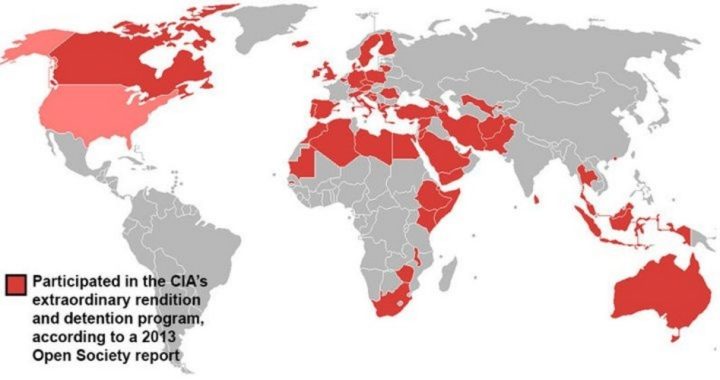
In response to a Freedom of Information Act lawsuit filed by the American Civil Liberties Union (ACLU), the Central Intelligence Agency (CIA) released 50 declassified documents on June 14 detailing its use of “expanded interrogation” (also called “enhanced interrogation”) — a government euphemism for torture techniques used on terrorist suspects following the 9/11 attacks.
Some of the techniques, such as waterboarding, are a combination of physical and psychological torture, while others — such as “mock burial” and the threatened use of supposedly stinging insects, are solely psychological.
The declassified documents quoted from a number of memos, e-mails, and documents, including one entitled “Description of Physical Pressures.” A report from CNN stated that this document discussed several potential physical and psychological pressures including a facial slap, the use of diapers, “insects,” and “mock burial.”
“One possibility is to threaten to place stinging insects into the cramped confinement box with” the detainee “but instead place harmless insects,” CNN quoted the document.
Another technique described in the document, a “mock burial” would involve placing the prisoner in “a cramped confinement box that resembles a coffin. The box has hidden air holes to prevent suffocation.”
“CIA officers and other personnel acting on behalf of CIA may use only Permissible Interrogation Techniques,” one memo quoted by CNN read. Among the permissible techniques were the highly publicized near-drowning technique known as waterboarding and forcing detainees to wear adult diapers for the purposes of “humiliation.”
The memo stated that the permissible techniques “do incorporate physical or psychological pressure beyond standard techniques,” but require medical and psychological personnel to be onsite during all interrogations employing these techniques and that those personnel “shall suspend the interrogation if they determine that significant and prolonged physical or mental injury, pain, or suffering is likely to result if the interrogation is not suspended.”
While some defenders of the CIA’s action have asserted that any interrogation technique that is not actually life threatening is justified if it potentially saves lives by stopping terrorism, in at least one case, a CIA interrogation resulted in the death of the suspect. That suspect, Gul Rahman, was captured and arrested in 2002 during a joint operation by U.S. CIA agents and Pakistani security forces and subsequently flown by the CIA to Afghanistan. Rahman was at the Salt Pit — the CIA code name for an abandoned brick factory that had been turned into a CIA covert “black site.”
The “enhanced interrogation” of suspects such as Rahman, who was never charged with any crime, could not have been done within U.S. territory, because such treatment of suspects is not allowed under U.S. law, which is why such black sites are always located in other nations.
A declassified report cited by CNN provided details of an investigation into Rahman’s death. The report detailed how he was subjected to constant music, sleep deprivation, stripped down to his diaper, and placed in an “extremely cold” cell. Rahman was determined to have died of hypothermia while in detention.
A report about Rahman’s death posted on the Vice News website went into much greater detail. It noted:
The prison is where a 34-year-old Afghan militant and suspected al-Qaeda operative named Gul Rahman froze to death in November 2002 after undergoing a brutal torture regimen that included being beaten, doused with cold water, and left half-naked while chained to the floor of his cell. Several of the techniques CIA interrogators used on Rahman were unauthorized; in August 2002, a Department of Justice attorney named John Yoo had written a legal memo sanctioning nearly a dozen torture methods for use on high-value captives.
Vice News One quoted from an email from the CIA’s chief of interrogations, who described the agency’s torture program as a “train wreak [sic] waiting to happen. I intend to get the hell off the train before it happens.”
Vice News went on to state that the heavily redacted January 28, 2003 report from the CIA’s Associate Deputy Director of Counterintelligence/Operations, entitled “Death Investigation — Gul Rahman,” and the IG report, entitled, “Death of a Detainee,” prepared by the CIA’s then–inspector general, John Helgerson, contains the most detailed description to date about the torture to which Rahman was subjected after he was rendered to COBALT (the CIA’s code name for the Salt Pit site).
Both reports, reported Vice News, said Rahman “was slapped, punched, given cold showers, dragged through the dirt while hooded, and hung by his arms in a stress position.”
Vice News concluded:
Rahman’s death was also highlighted in the Senate’s torture report, which concluded that torturing detainees did not produce any “unique” or “valuable” intelligence about pending terrorist attacks.
It is important to remind ourselves that the above descriptions of the conditions leading to Rahman’s death were not written about events that occurred in the Soviet-era KGB’s Lubyanka prison in Moscow, but in a secret facility operated by an agency of the U.S. government.
This latest release of documents related to the CIA’s “enhanced interrogation” methods, follows the Senate Intelligence Committee’s release on December 9, 2014 of the summary of its report on the CIA’s detention and interrogation activities. While many Republicans were critical of the report because it cast a negative light on a program initiated during the administration of George W. Bush, and it was compiled by a committee chaired by Democrat — Dianne Feinstein — at least one prominent Republican praised the report and condemned CIA torture.
Among the critical Republicans were Senators Jim Risch (R-Idaho) and Marco Rubio (R-Fla.), who issued a joint statement in advance of the report’s release that harshly condemned the committee’s action. “This report does not qualify as either serious or constructive,” the two senators wrote. “This was a partisan effort that divided members of the committee, and the committee against the people of the CIA.”
The Risch-Rubio statement continued:
As a nation at war, we need a coherent detention and interrogation policy in order to extract valuable intelligence about terrorist networks from captured operatives. The Obama Administration has no detention policy, and it has hindered U.S. efforts to fight terrorism globally.
The senators apparently believed that being engaged in warfare (though Congress has not passed a declaration of war since June 5, 1942) is sufficient justification for a civilian government agency (which the CIA is) to ignore several statements found in the Bill of Rights, such as the Fifth Amendment’s prohibition against holding a person accountable for a crime without an indictment from a grand jury, the Sixth Amendment’s guarantee of a speedy and public trial in the state or district where the crime was committed, or the Eighth Amendment’s prohibition against cruel and unusual punishment.
Because it is aware of these violations, the CIA established “black sites” outside of U.S. jurisdiction where it could conduct its “enhanced interrogation” operations in secret.
Among those taking an opposite position, however, was the 2008 Republican presidential nominee, Senator John McCain, who delivered a statement on the Senate floor about the committee’s intelligence report that stated, in part:
I rise in support of the release — the long-delayed release — of the Senate Intelligence Committee’s summarized, unclassified review of the so-called “enhanced interrogation techniques” that were employed by the previous administration to extract information from captured terrorists. It is a thorough and thoughtful study of practices that I believe not only failed their purpose — to secure actionable intelligence to prevent further attacks on the U.S. and our allies — but actually damaged our security interests, as well as our reputation as a force for good in the world.
This response undoubtedly pleasantly surprised many constitutionalists, since McCain is part of the neoconservative wing of the Republican Party and has a reputation as a “hawk” on military intervention overseas. However, McCain’s experience at being tortured by the North Vietnamese while he was a prisoner of war may have had an impact on his lack of sympathy for “enhanced interrogation.” This outlook was indicated by McCain’s further comments:
I know from personal experience that the abuse of prisoners will produce more bad than good intelligence. I know that victims of torture will offer intentionally misleading information if they think their captors will believe it…. I know the use of torture compromises that which most distinguishes us from our enemies, our belief that all people, even captured enemies, possess basic human rights, which are protected by international conventions the U.S. not only joined, but for the most part authored.
Perhaps a little more surprising than McCain’s support of the report was Senator Rand Paul’s very restrained support of it. (Senator Paul regularly condemns unconstitutional big-government initiatives.) “It’s important that people take a stand and representatives take a stand on whether they believe torture should be allowed. I think we should not have torture,” Paul said. “Transparency is mostly good for government. The only thing I would question is whether or not the actual details, the gruesomeness of the details, will be beneficial or inflammatory.”
In contrast, Paul’s father, the former Representative Ron Paul (R-Texas), was very definite in his condemnation of waterboarding during the Republican presidential candidates’ debate on November 12, 2011:
It’s illegal under international law and under our law. It’s also immoral, and it’s also very impractical…. There’s no evidence that you really get reliable evidence.
While the Republican Party’s 2008 presidential nominee agreed with Ron Paul in opposing such “enhanced interrogation,” this year’s presumptive nominee apparently sees nothing wrong with the practice.
Speaking on This Week With George Stephanopoulos last November, Donald Trump said he “would absolutely bring back interrogation and strong interrogation,” including waterboarding. “You know, they don’t use waterboarding over there; they use chopping off people’s heads,” Trump said. “I would bring it back. I think waterboarding is peanuts compared to what they’d do to us.”
Countries that participated in the U.S. rendition program: opensocietyfoundations.org
Related articles:
Trump Promises to Bring Back Waterboarding
Controversy Continues Regarding Senate Committee Report on CIA Torture
Senate Intelligence Committee Releases Report on CIA Torture
Release of U.S. Senate Report on CIA Torture Delayed
EU Court: Poland Hosted Secret CIA Torture Facility
Indefinite Imprisonment Moves Toward Final Passage
“Criminal Standard of Proof” of CIA Torture in Poland
AP Reports: CIA “Black Site” Prison in Romania Identified
Dick Cheney, Mohammad Jawad and Torture
CIA Torture Investigation Declassified
Unhappy Veterans Day: Court Rules Veteran May Not Sue His Gov’t Torturers



